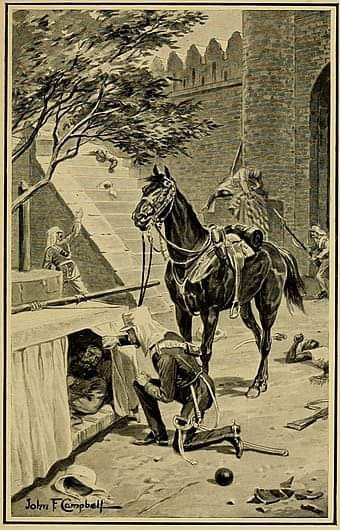September 14, 1857: The Day When John Nicholson Faced the Fury of Indian Sepoys"
September 14, 1857, stands as a pivotal date in the annals of Indian history, marking the day when Acting Brigadier John Nicholson faced grave peril during the assault on Delhi. This remarkable episode took place against the backdrop of the Indian Rebellion of 1857, a turbulent period in India's struggle for independence from British colonial rule. The events of that day serve as a gripping narrative that weaves together the threads of courage, sacrifice, and the complex interplay of power during this tumultuous time.
Setting the Stage: The Indian Rebellion of 1857
The Indian Rebellion of 1857, often referred to as the Sepoy Mutiny or Indian Mutiny, was a watershed moment in India's history. It began on May 10, 1857, in the town of Meerut, when Indian soldiers, known as sepoys, revolted against their British officers. The uprising quickly spread across various regions of India, with the city of Delhi emerging as a focal point of the rebellion.
John Nicholson: A Man of Remarkable Stature
Central to this saga was the towering figure of John Nicholson. Born on December 11, 1821, in Lisburn, Ireland, Nicholson's entry into the British East India Company's Bengal Army at the tender age of 17 marked the beginning of a storied career. His rapid ascent through the ranks was attributed to his extraordinary leadership skills, unflinching bravery, and exceptional administrative abilities. Nicholson was a man of unwavering loyalty to the British Crown, and his ruthless determination was often employed in the service of the empire.
The Fateful Assault on Delhi
The assault on Delhi was a critical juncture in the Indian Rebellion of 1857. The city had become both a symbolic and strategic stronghold for the mutineers, making its recapture a paramount objective for the British. John Nicholson assumed a pivotal role in this endeavor, leading his troops with valor and determination.
The Battle and Nicholson's Critical Injury
On that fateful September day in 1857, as the British forces closed in on Delhi, a ferocious battle ensued. Amidst the chaos and the deafening roar of gunfire, John Nicholson was grievously wounded when a bullet struck his chest. Despite his severe injuries, Nicholson displayed astonishing fortitude and continued to lead his troops until victory was secured. His unyielding resolve served as an inspiration to his men and earned him a place in history's annals.
The Aftermath and a Contested Legacy
Tragically, John Nicholson's wounds proved to be mortal, and he passed away on September 23, 1857. His death was a profound loss for the British, and they commemorated his sacrifice by erecting a memorial in his honor in Delhi.
However, Nicholson's legacy remains complex and contested. While he is celebrated as a hero by the British, in India, his name evokes mixed sentiments. For some, he symbolizes the oppressive might of the British Raj. His life and actions, as well as the broader context of the Indian Rebellion of 1857, continue to be analyzed from diverse perspectives.
Conclusion
September 14, 1857, will forever be etched in history as the day when Acting Brigadier John Nicholson faced mortal danger in the heart of Delhi. His unwavering courage in the face of overwhelming odds made him an iconic figure during the Indian Rebellion of 1857. Yet, his legacy remains a subject of debate and contemplation, a reminder of the intricate tapestry of historical events and the indomitable individuals who shape them. It is a story of a day when history came alive, and one man's valor became a symbol of resilience in India's relentless struggle for independence.
Follow me up for more such articles and if you wana watch History Videos do visit my YouTube channelYouTube Channel : The Tiger of Mysore
Follow me on Instagram
https://www.instagram.com/thetigerofmysore
Follow my Facebook page




Comments
Post a Comment